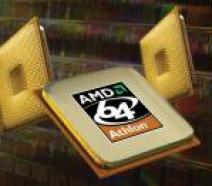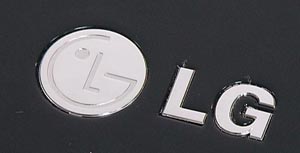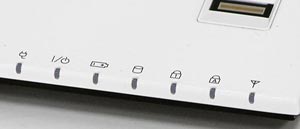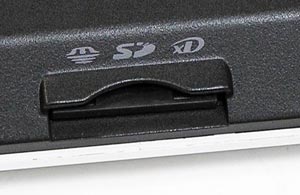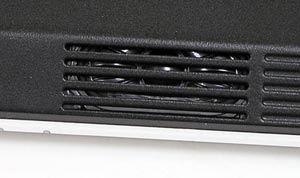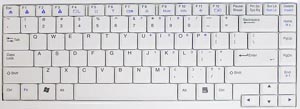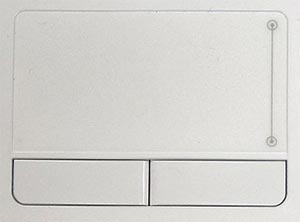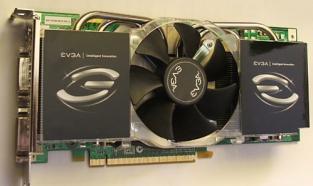LG T1 REVIEW NOTEBOOK PERFORMANCE BENCHMARK
![]()
|
|
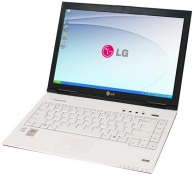 |
||||||||||||
| Posted:2006-06-09 By notebook review Number of View:212465 |
|||||||||||||
By :notebook review Posted:2006-06-09
LG’s T1 is the first notebook in this review that is based on Intel’s new mobile platform. LG has done a good job on this one and made some great progress since the LW40. The new platform is parceled into a smaller case, weighs less, and boasts a better configuration (it lacks integrated graphics which is available in the LW40, but this doesn’t matter much for the user group the T1 is targeted at). The new Bluetooth adapter (BlueCore 4) needs a special mention as the T1 is among the first notebooks to feature it. Also remarkable in the T1 is the new low-consumption Intel L2300 processor (1.5GHz clock rate) that promises a long battery life. The exterior design is perhaps the single thing in this new model that is not perfect.
The “piano finish black” plastic of the lid that owners of expensive hi-fi equipment may be familiar with just cannot possibly remain long in its ideal pristine state. Unlike hi-fi devices, a notebook is supposed to be carried about, so all this finish will wear off eventually. This is in fact a common problem of all notebooks whose cases are designed like that. The case quickly gets covered with a cobweb of micro-scratches unless you carry the notebook in a velvet pouch and handle it very carefully. The snow-white keyboard margin is made of the same plastic and your fingerprints are very visible on it. Well, it is sure to wear off eventually even if you work in gloves. Still I don’t think this will be a problem for anyone who sees this notebook live – LG has made a truly stylish device in which every element is well-placed. Even the logotype has been made smaller and fitted snugly into the computer’s lid.
he notebook status indicators are placed properly, too:
The front view reminds me of the advertising videos of ultra-thin cell phones:
The card-reader’s position is somewhat unusual:
It is in the middle and closer to the bottom of the front panel. As the result, it is not very easy to use. And funnily enough, the labels of the supported formats are printed upside down. Like the LW40’s, the card-reader of this model supports xD cards, too. There are also two speakers of the integrated audio system on the front panel:
Unfortunately, the new platform hasn’t brought any improvements in the sound quality field. Without headphones, this audio system is only sufficient for reproducing Windows’ system sounds, and it seems like notebook owners cannot hope to hear a decent sound in near future. This is a whole new story, though, and we are going to cover it in our upcoming review of desktop-replacement systems which have progressed more in this respect, at least you can use them to play some background music. On the notebook’s back panel there is a battery, video output, modem and LAN sockets, and a power adapter connector. So, they placed at the back everything that indeed should be there but nothing else (like USB ports). The remaining connectors are located on the notebook’s sides. Two USB ports at a long enough distance from each other are on the left panel next to a D-Sub connector for an external monitor, a FireWire port and a set of audio connectors: Besides the DVD-burner, traditional for systems of this level, there is one USB port and an ExpressCard/34 slot like in the LW40. You should be aware that manufacturers of PC peripherals aren’t very eager to produce expansion cards for this progressive slot, but there are a lot of notebooks on the market that have both ExpressCard and PCMCIA slots. The pearl-white keyboard has a standard layout:
LG traditionally combines Delete and Insert in one button. Otherwise, everything’s ordinary. The arrow keys are separate from the rest of the keyboard:
A row of text navigation buttons is on the right: They also serve as display brightness controls. The touchpad matches the overall design concept of this notebook:
It is almost invisible. The sensitive area is only half a millimeter below the level of the case, the buttons aren’t conspicuous against the background. The only manufacturing flaw I could spot was about the grid the microphone hides under.
It looks as if they forgot to finish it off with a file. That’s not a serious defect, of course, rather a minor flaw of first demo models, yet I think the LW series should be free even from such small imperfections. As for the display, it has average parameters, sufficient for office use. The main advantage of this display is the extremely high native resolution of 1440x900. The T1 is capable of displaying more useful information that its opponents, but having good eyesight is strongly recommended for working with a picture displayed at such a high resolution on such a small screen! The user is not given free access to the components. You have to take the notebook apart to get to the hard drive or memory stick. The vent opening is placed improperly, just like in the LW series notebooks: it’s going to be uncomfortable to have this notebook on your laps. LG produced a new battery for the new series:
As a result, we’ve got a very interesting notebook with excellent size/weight characteristics, very good configuration, and impressive exterior design. There’s a lot of winning features about this model: a very high display resolution, minimum weight in its category, good battery, rather fast but low-consumption processor, and a new hardware platform. The notebook lacks integrated graphics, but this is not important, considering its target audience. If the T1 has reached the shops before you make up your mind to buy a widescreen 14” notebook, don’t miss it – it is certainly worthy of a look! PerformanceFirst I checked the notebooks in Business Winstone 2004 and Content Creation Winstone 2004 benchmarks LG T1 winstone benchmarkAnd here are the results produced by PCMark04: LG T1 pcmark performanceThe results of the Photoshop CS are indicative of the overall performance of the CPU, platform and hard drive: LG T1 adobe photoshopThe well-balanced LW40 is almost as fast as the two notebooks on the new platform. Other notebooks are slower. The two slowest models shouldn’t be used to run such applications at all – they are only capable of performing office tasks like processing text and spreadsheets, browsing the Web, etc. The next test shows what you can expect from these notebooks in gaming applications: LG T1 gaming benchmarkperformed this test using the maximum display resolution of each notebook, except for the LG T1 (I used 1280x800 with it because 1440x900 would have been too much for its integrated graphics core). The Acer TravelMate 3222WXMi is the best and can cope with modern games if you don’t use the highest graphics quality settings. Among other notebooks, only models with the X600 are interesting. The Samsung X11 is second after the TravelMate 3222WXMi but I doubt it’s going to be that fast in real games. I also published the results of the CPU subtest to show you that 3DMark03 favors the Centrino Core Duo platform. This is indicated by the Samsung X11’s results. This platform is the most promising one when it comes to games, considering that all the leading game developers have confirmed support for dual-core processors in their upcoming products. And now, the results of the most important test: I put the results the notebooks achieved in Reader’s mode and under maximum load into one diagram because the difference between the two is indicative of how well the manufacturer set up the power-saving parameters. The Sony VGN-FJ1SR looks best here as it yields you its full computing power under max load but is very economical in Reader’s mode. Besides the Sony, there are two more leaders: LG’s T1 with a high-capacity battery and an L series Core Duo processor which features low power consumption, and ASUS W3H00V. The latter proved to be a bit of a cheater, though. Even under max load with the portable/laptop power management scheme selected this notebook never increased its CPU frequency higher than 1.3GHz. It’s all clear with the first two diagrams, but then there are some things I’d want to single out. The LW40 is very fast in the memory test; it’s the best Centrino-based notebook I’ve seen in this benchmark. The Acer TravelMate 3222WXMi is unrivalled in the graphics subsystem test just because it has the fastest graphics adapter among the tested notebooks. Nvidia’s GeForce Go 7400 is downright disappointing. If you need fast graphics, buy a notebook that has dedicated graphics memory. Graphics subsystems of other kind (with such suffixes as TC, HM) are not much better than integrated graphics and cannot ensure high performance in 3D. In the disk subsystem test the notebooks rank up according to the spindle rotation speed of the hard drive they use. Other related notebook: Acer TravelMate 3222WXMi notebook review
we would be happy to answer for your question . if you have suggestion or comment
regarding this review our support would be glad to help just join our forum and ask u will get the best answer
to discuss check our forum section :-) RATE THIS REVIEW | |||||||||||||
![]()

7600gt review
7600gt is the middle card range.
We already benchmarked this video card and found that ...

 geforce 8800gtx and 8800gts
geforce 8800gtx and 8800gts  Xtreview software download Section
Xtreview software download Section  AMD TURION 64 X2 REVIEW
AMD TURION 64 X2 REVIEW  INTEL PENTIUM D 920 , INTEL PENTIUM D 930
INTEL PENTIUM D 920 , INTEL PENTIUM D 930  6800XT REVIEW
6800XT REVIEW  computer hardware REVIEW
computer hardware REVIEW  INTEL CONROE CORE DUO 2 REVIEW VS AMD AM2
INTEL CONROE CORE DUO 2 REVIEW VS AMD AM2  INTEL PENTIUM D 805 INTEL D805
INTEL PENTIUM D 805 INTEL D805  Free desktop wallpaper
Free desktop wallpaper  online fighting game
online fighting game  Xtreview price comparison center
Xtreview price comparison center 

- The new version of GPU-Z finally kills the belief in the miracle of Vega transformation
- The motherboard manufacturer confirms the characteristics of the processors Coffee Lake
- We are looking for copper coolers on NVIDIA Volta computing accelerators
- Unofficially about Intels plans to release 300-series chipset
- The Japanese representation of AMD offered monetary compensation to the first buyers of Ryzen Threadripper
- This year will not be released more than 45 million motherboards
- TSMC denies the presentation of charges from the antimonopoly authorities
- Radeon RX Vega 64 at frequencies 1802-1000 MHz updated the record GPUPI 1B
- AMD itself would like to believe that mobile processors Ryzen have already been released
- AMD Vega 20 will find application in accelerating computations
- Pre-orders for new iPhone start next week
- Radeon RX Vega 57, 58 and 59: the wonders of transformation
- ASML starts commercial delivery of EUV-scanners
- The older Skylake processors with a free multiplier are removed from production
- Meizu will release Android-smartphone based on Helio P40
- AMD Bristol Ridge processors are also available in American retail
- The fate of Toshiba Memory can be solved to the next environment
- duo GeForce GTX 1080 Ti in GPUPI 1B at frequencies of 2480-10320 MHz
- New Kentsfield overclocking record up to 5204 MHz
- Lenovo released Android-smartphone K8



computer news computer parts review Old Forum Downloads New Forum Login Join Articles terms Hardware blog Sitemap Get Freebies
